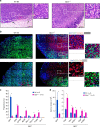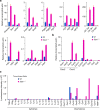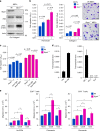Sipa1 deficiency unleashes a host-immune mechanism eradicating chronic myelogenous leukemia-initiating cells
- PMID: 29500416
- PMCID: PMC5834470
- DOI: 10.1038/s41467-018-03307-8
Sipa1 deficiency unleashes a host-immune mechanism eradicating chronic myelogenous leukemia-initiating cells
Abstract
Chronic myelogenous leukemia (CML) caused by hematopoietic stem cells expressing the Bcr-Abl fusion gene may be controlled by Bcr-Abl tyrosine kinase inhibitors (TKIs). However, CML-initiating cells are resistant to TKIs and may persist as minimal residual disease. We demonstrate that mice deficient in Sipa1, which encodes Rap1 GTPase-activating protein, rarely develop CML upon transfer of primary hematopoietic progenitor cells (HPCs) expressing Bcr-Abl, which cause lethal CML disease in wild-type mice. Resistance requires both T cells and nonhematopoietic cells. Sipa1-/- mesenchymal stroma cells (MSCs) show enhanced activation and directed migration to Bcr-Abl+ cells in tumor tissue and preferentially produce Cxcl9, which in turn recruits Sipa1-/- memory T cells that have markedly augmented chemotactic activity. Thus, Sipa1 deficiency uncovers a host immune mechanism potentially capable of eradicating Bcr-Abl+ HPCs via coordinated interplay between MSCs and immune T cells, which may provide a clue for radical control of human CML.
Conflict of interest statement
This work was supported in part by research funding from Sumitomo Dainippon Pharma Co., Ltd.
Figures








Similar articles
-
Role of SPA-1 in phenotypes of chronic myelogenous leukemia induced by BCR-ABL-expressing hematopoietic progenitors in a mouse model.Cancer Res. 2006 Oct 15;66(20):9967-76. doi: 10.1158/0008-5472.CAN-06-1346. Cancer Res. 2006. PMID: 17047059
-
Modification of Gene Expression, Proliferation, and Function of OP9 Stroma Cells by Bcr-Abl-Expressing Leukemia Cells.PLoS One. 2015 Jul 28;10(7):e0134026. doi: 10.1371/journal.pone.0134026. eCollection 2015. PLoS One. 2015. PMID: 26218064 Free PMC article.
-
Targeting of the BLT2 in chronic myeloid leukemia inhibits leukemia stem/progenitor cell function.Biochem Biophys Res Commun. 2016 Apr 15;472(4):610-6. doi: 10.1016/j.bbrc.2016.03.018. Epub 2016 Mar 8. Biochem Biophys Res Commun. 2016. PMID: 26966074
-
Chemokines as a Conductor of Bone Marrow Microenvironment in Chronic Myeloid Leukemia.Int J Mol Sci. 2017 Aug 22;18(8):1824. doi: 10.3390/ijms18081824. Int J Mol Sci. 2017. PMID: 28829353 Free PMC article. Review.
-
Chronic Myeloid Leukemia in the Era of Tyrosine Kinase Inhibitors: An Evolving Paradigm of Molecularly Targeted Therapy.Mol Diagn Ther. 2016 Aug;20(4):315-33. doi: 10.1007/s40291-016-0208-1. Mol Diagn Ther. 2016. PMID: 27220498 Review.
Cited by
-
SIPA1 Regulates LINC01615 to Promote Metastasis in Triple-Negative Breast Cancer.Cancers (Basel). 2022 Oct 1;14(19):4815. doi: 10.3390/cancers14194815. Cancers (Basel). 2022. PMID: 36230738 Free PMC article.
-
Rap1 signal modulators control the maintenance of hematopoietic progenitors in bone marrow and adult long-term hematopoiesis.Cancer Sci. 2019 Apr;110(4):1317-1330. doi: 10.1111/cas.13974. Epub 2019 Mar 18. Cancer Sci. 2019. PMID: 30767320 Free PMC article.
-
SIPA1 promotes angiogenesis by regulating VEGF secretion in Müller cells through STAT3 activation.Heliyon. 2024 Jan 17;10(2):e24869. doi: 10.1016/j.heliyon.2024.e24869. eCollection 2024 Jan 30. Heliyon. 2024. PMID: 38312659 Free PMC article.
-
Physiology and pathology of T-cell aging.Int Immunol. 2020 Apr 12;32(4):223-231. doi: 10.1093/intimm/dxaa006. Int Immunol. 2020. PMID: 31967307 Free PMC article. Review.
-
SIPA1 promotes epithelial-mesenchymal transition in colorectal cancer through STAT3 activation.Heliyon. 2024 Jul 17;10(14):e34527. doi: 10.1016/j.heliyon.2024.e34527. eCollection 2024 Jul 30. Heliyon. 2024. PMID: 39130435 Free PMC article.
References
Publication types
MeSH terms
Substances
LinkOut - more resources
Full Text Sources
Other Literature Sources
Medical
Molecular Biology Databases
Research Materials
Miscellaneous

